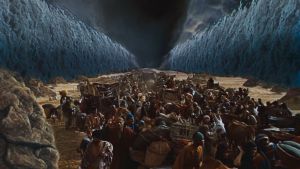The Feast of Unleavened Bread
The Feast of Unleavened Bread is a feast of God kept on the fifteenth day of the first month according to the sacred calendar. It is also called the Feast of Affliction in the New Testament times. It was established to remember the suffering the Israelites experienced from the day after the Passover until they finished crossing the Red Sea. This represented Christ’s suffering on the cross in the New Testament times. It is also the name of the first group of the Feasts (Passover, Feast of Unleavened Bread) among the three groups of the feasts that God commands us to keep.[1]
Origin of the Feast of Unleavened Bread
After Jacob and his family moved to Egypt, Israel became a large nation in the land of Goshen. However, when a new Pharaoh, who did not know Joseph, sat on the throne, he enslaved the Israelites in Egypt. For about 400 years, they were charged with dangerous tasks such as building Pithom and Rameses as store cities for Egypt. When the cries of the Israelites reached heaven, God sent the prophet Moses to lead them out.
Nine plagues were sent, followed by the last plague of the death of every firstborn son in each family. When Pharaoh surrendered to God’s power, the Israelites left Egypt the day after they celebrated the Passover. Since they had no time to prepare any other food, they baked loaves of unleavened bread made from the dough without yeast.[2]
On the 15th day of the first month of the sacred calendar, the Israelites, who departed from Rameses, arrived at the Red Sea and camped there. There were about six hundred thousand men. After losing his workforce, Pharaoh changed his mind and ordered his soldiers to bring the Israelites back. He led his army to pursue the Israelites. As Pharaoh’s army was approaching, the Israelites were terrified and cried out to God and started to complain against Moses. They felt they were in a great dilemma because the sea was blocking their way and the enemies were coming toward them.
The Egyptians—all Pharaoh’s horses and chariots, horsemen and troops—pursued the Israelites and overtook them as they camped by the sea near Pi Hahiroth, opposite Baal Zephon. As Pharaoh approached, the Israelites looked up, and there were the Egyptians, marching after them. They were terrified and cried out to the LORD . . . Then the LORD said to Moses, “Why are you crying out to me? Tell the Israelites to move on. Raise your staff and stretch out your hand over the sea to divide the water so that the Israelites can go through the sea on dry ground. I will harden the hearts of the Egyptians so that they will go in after them.”
God divided the Red Sea through the staff of Moses and led the people through it on dry land. He also delayed the pursuit of the Egyptian army with a pillar of cloud and that of fire.[3] The Israelites suffered fear, anxiety, and tension until every one of them finished crossing the sea. God instituted the Feast of Unleavened Bread to have them remember this suffering. The Feast of Unleavened Bread means the “feast of eating unleavened bread” and its name implies suffering.
Ceremony of the Feast of Unleavened Bread
Old Testament
In order to remember the suffering the Israelites experienced until they finished crossing the Red Sea, they ate unleavened bread for seven days from the evening of the 14th to the 21st of the first month of the sacred calendar. Unleavened bread was called the bread of affliction.[4] For seven days they presented an offering made by fire, and on the seventh day, they held a sacred assembly.[5][6]
New Testament
The suffering the Israelites experienced until they finished crossing the Red Sea represents the suffering of Jesus Christ on the cross. In the New Testament times, the saints participate in the suffering of Christ by worshiping and fasting on this day.
“But the time will come when the bridegroom will be taken from them, and on that day they will fast.”
Fulfillment of the Prophecies
The Feast of Unleavened Bread symbolizes suffering. It represents the suffering Jesus Christ would endure by carrying the cross until His death, following the celebration of His last Passover with His disciples.
Jesus was arrested on the night of the Passover. His suffering began from that time. The next day, He was hung on the cross for six hours from 9 a.m. to 3 p.m.[7] As a sin offering to pay for mankind’s sins,[8][9] He was pierced, wounded, flogged, afflicted, and interrogated just as prophesied in the Bible.[10]
The Israelites entering the Red Sea represents Jesus entering the tomb, and their emergence from the Red Sea represents Jesus’ resurrection. Baptism is a profound example of this symbolism.[11][12] Whoever believes and is baptized has symbolically crossed the Red Sea and entered the desert of faith. By observing the Feast of Unleavened Bread and participate in Christ’s sufferings, we receive power from God to endure hardships and trials that we will face in the future, and we also participate in the glory of the resurrection.[13]
See also
- Passover
- Feast of Firstfruits
- Feast of Weeks
- Feast of Trumpets
- Day of Atonement
- Feast of Tabernacles
- Feasts of God
References
- ↑ "Deuteronomy 16:16".
- ↑ "Exodus 12:29–39".
- ↑ "Exodus 14:19–25".
- ↑ "Deuteronomy 16:1–3".
- ↑ "Leviticus 23:6–8".
- ↑ "Deuteronomy 16:8".
- ↑ "Matthew 26-27".
- ↑ "Matthew 20:28".
- ↑ "1 Corinthians 5:7".
- ↑ "Isaiah 53:5–8".
- ↑ "1 Corinthians 10:1–2".
- ↑ "1 Peter 3:21".
- ↑ MY SHEEP LISTEN TO MY VOICE, Kim Joo-Cheol, Melchizedek Publishing Co., LTD., 2021, Chapter 15, The Feasts of God, pg. 176






